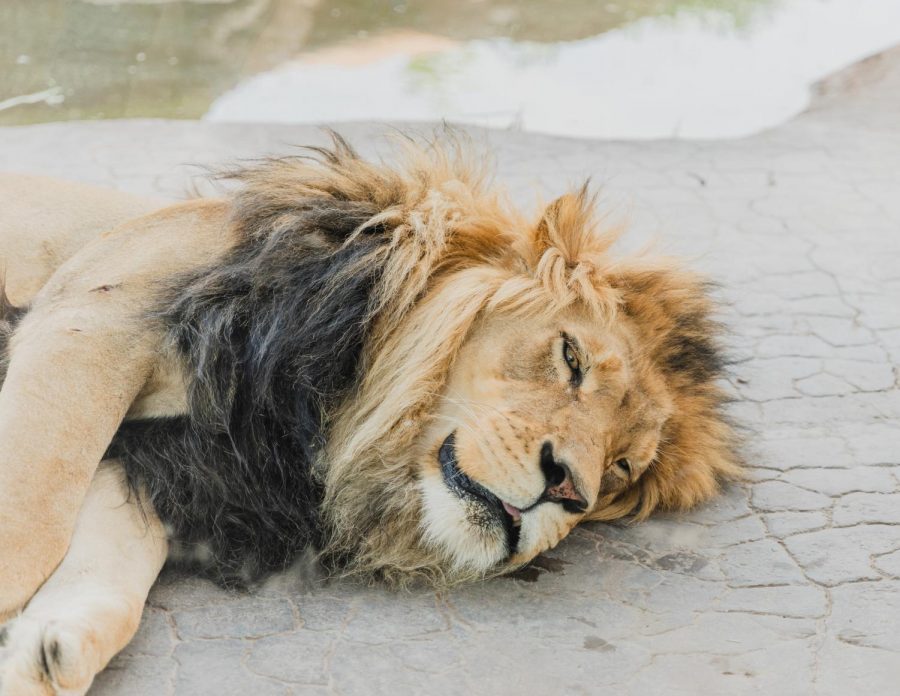Cushman: Utah Must Protect Its Animals in Captivity
A lion lays down in a Hole Zoo exhibit in Salt Lake City on June 16, 2021. (Photo by Silvana Peterson | The Daily Utah Chronicle)
June 17, 2021
As a kid, my parents often took me to Utah’s Hogle Zoo. Being the know-it-all I was, I’d spout new animal facts I had learned to anyone I talked to after our visits. Many of us likely share similar childhood memories of visiting zoos and aquariums. However, when I returned to Hogle Zoo as an adult this year, I found it lacking the wonder I’d known as a child. Instead, it saddened me to see the animals stuck in small habitats that bore little resemblance to their natural ones. And they had no privacy with all the children pressed up against the glass.
Utah’s Hogle Zoo maintains a better environment for their animals than many other zoos, even within the state. Lagoon houses 40 animals, including many big cats, in terrible conditions. Their pens are too small for the animals and don’t provide adequate protection from park patrons. Compared to Lagoon, places like Hogle Zoo and the Loveland Living Planet Aquarium almost feel like animal sanctuaries, but that does not change the fact that captivity actively harms animals. Utah needs to require higher standards of care for all animals in captivity.
The Reality of Keeping Animals in Captivity
It’s been shown time and time again that animals in captivity suffer. The orca is perhaps the most well-known example of the toll captivity can have on animals. In the wild, orcas live complex lifestyles which cannot be replicated in a small tank. Orcas in captivity die much younger, struggle to exercise properly and cannot maintain the social bonds they would have in the wild. This disruption to their lives causes captive orcas to act more aggressively towards trainers and other orcas. Sometimes orcas in captivity grow so stressed that they will even self-mutilate.
Like the orca, other animals, such as big cats, elephants, birds and sharks, all experience intense stress in captivity. While each species will have a different and unique experience in captivity, every captive animal is deprived of its natural habitat and social structure to be gawked at by us humans.
Do Zoos Have a Positive Influence?
The harm experienced by captive animals has long motivated animal rights activists to advocate against keeping animals in zoos. For just as long, zoos and aquariums have justified their existence as vital institutions for conservation and education. The San Diego Zoo, for instance, helped save the California condor from extinction, bringing the population from only 22 in the wild in 1982 to over 400, with 240 living in the wild.
Utah’s own institutions play a role in conservation. The Loveland Living Planet Aquarium takes part in several Species Survival Plan Programs. This coral rescue initiative works to educate about sustainable food and tries to reuse and conserve water in the aquarium as much as possible.
The Hogle Zoo donates proceeds from its carousel to conservation, works towards sustainability in its own operations and takes part in conservation groups like 96 Elephants and Wild Aware Utah.
Speaking from my own experience, going to the Hogle Zoo as a child taught me the importance of conservation. Seeing animals in real life while learning about threats to their survival like habitat encroachment and poaching lead me to be passionate about conservation as an adult.
Utah’s Animals Must Also Be Protected
Zoos in our state serve as a harmful institution for the animals who live there, while also providing an educational and conservation-focused experience for their guests. If Utah creates higher standards for animal care, then the zoos in our state can be more humane for the animals we claim to care about.
Humane animal housing reform should focus on animal habitats and socialization. To legally house animals now, an institution needs to comply with the national Animal Welfare Act, which requires caretakers to provide food, water and veterinary care. But it fails to address the habitation and social needs of animals.
Our state should pass laws that require certain habitat sizes and designs and allow for animals to socialize in a healthy way based on their natural needs. Laws that require zoos and aquariums to house animals more humanely would make happier animals and happier zoo visits for every guest.
Additionally, zoos currently function as a family adventure. The state can also consider shifting the focus to educating guests and making them a part of conservation efforts. This would give adults a reason to come back to support conservation efforts.
We must start making drastic changes to the way we think about zoos if we want to resolve the big problems they present. Designing zoos solely with our entertainment in mind makes it impossible for the animals who live there to be healthy and happy. Even though Utah’s own zoos and aquariums treat animals slightly better than circuses or roadside zoos, we shouldn’t be content with the bare minimum.










john • Jul 3, 2021 at 11:22 am
zoos are barbaric. they must be eliminated.